RC airplane controls are, of course, the same as those found on real airplanes, and they control the model plane in exactly the same way.
The four primary controls of an rc airplane are throttle, elevator, ailerons and rudder. The elevator, ailerons and rudder are collectively known as control surfaces, and the picture below shows where these main controls are located on a fairly typical 4 channel aerobatic rc airplane....
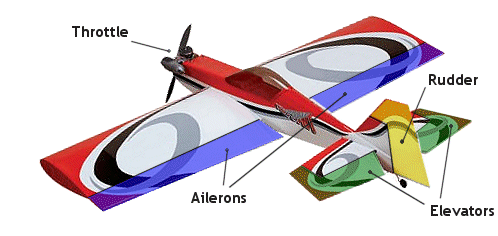
Above, location of ailerons, elevators and rudder on an rc airplane
Which controls do what?
Throttle
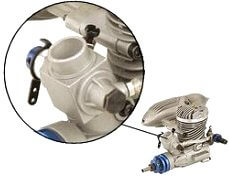 Throttle controls the speed of the motor.
Throttle controls the speed of the motor.In a nitro, or 'glow plug', engine (shown right) the throttle works the same as any internal combustion engine throttle, by changing the amount of fuel and air that enters the combustion chamber of the engine.
In an electric rc airplane the throttle is usually referred to as motor control or speed control. Basic electric rc planes might not feature proportional speed control, but just a simple on/off switch instead.
In the air, throttle not only controls the speed of the airplane, but also the rate of climb and descent, because different amounts of lift are generated at different airspeed. For example, if your landing approach path is too low you can make the airplane rise slightly without changing speed, simply by opening the throttle instead of using elevator. Conversely, closing the throttle will cause the airplane to sink before the speed reduces.
Elevators
The elevators are the hinged section of the tailplane, or horizontal stabilizer, at the very rear of the airplane.Elevators control the pitch attitude of the rc airplane, in other words the angle of the plane in relation to the horizontal.
When elevators are in the up position, the nose of the airplane is forced to point upwards and so the plane climbs. With the elevators down, the nose is forced downwards and the plane begins to dive.

Very basic rc airplanes might not have elevator control, however - motor control may be the primary way of controlling altitude.
Elevators are always used in conjunction with rudder and/or ailerons when making a turn.
Ailerons
Not all rc airplanes have aileron control, in fact the majority of 3 channel airplanes use rudder instead. But, where fitted, ailerons control the roll of the airplane about its longitudinal axis (imagine a straight line running from nose to tail).Ailerons always come in pairs and are found on the trailing (rear) edge of the wing, and they work opposite to each other ie when one aileron moves up, the other one moves down and vice versa..
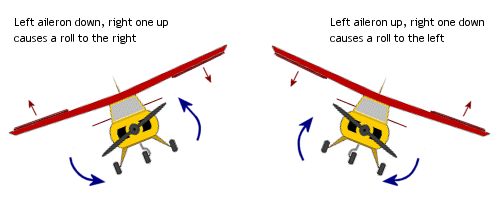
When used in conjunction with elevators, ailerons cause the airplane to turn, and are also used in all aerobatic maneuvers that require the airplane to roll.
Rudder
The rudder is the hinged section of the fin, or vertical stabilizer, at the rear of the airplane.It's used for directional control by changing the yaw of the airplane, and works in the correct sense ie moving the rudder to the left causes the airplane to turn left and vice versa.
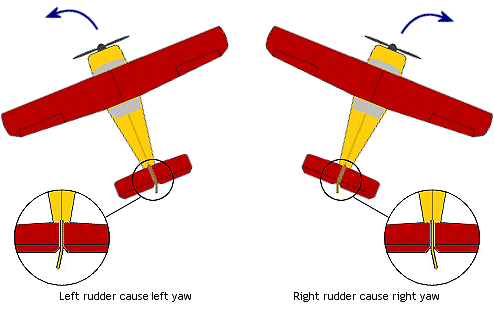
Yaw is different to roll because when an airplane yaws to the left or right because of rudder it remains more or less level. Only the combined use of rudder and elevator causes an airplane to bank in the same way as ailerons cause it to.
After throttle, or electric motor on/off, the rudder is the second most used rc airplane control - without it, your plane would simply fly off in to the distance!
Other RC airplane controls
Other controls found on more complex rc airplanes include flaps and retractable landing gear, or 'retracts'.Flaps are located on the trailing edge of each wing, between the aileron and fuselage. They're used to generate more lift at slower flying speeds, and to slow the airplane down close to landing.
Unlike ailerons, flaps are connected in such a way that they both drop exactly the same amount together.
The flaps will usually be operated by rotating a small dial on the face or top of the transmitter. This allows the pilot to use as little or as much flap as he wants, according to the situation.
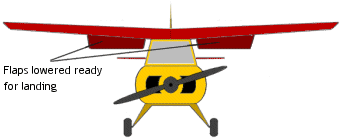
Retractable landing gear (undercarriage) is landing gear that folds away into the airplane's wings or fuselage, as soon as the plane has taken off.
Retracts are often used on larger rc airplanes, particularly scale models where the real airplane has retractable undercarriage - warbirds, for example.
Larger non-scale airplanes also often have retracts, particularly competition aerobatic airplanes where it's necessary to reduce the amount of drag on the plane in the air. Obviously an airplane with no landing gear hanging below it experiences a lot less drag than one with
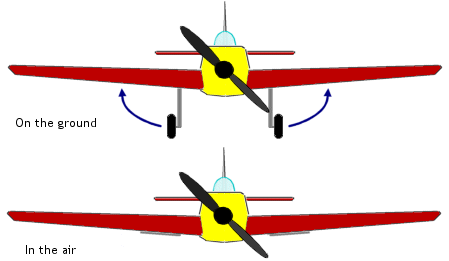
Retracts can be operated mechanically by a servo, or driven by compressed air. The retraction of the landing gear is operated by the flicking of a single switch on the transmitter, either on the 5th or 6th channel.
Control surface mixing
Some rc airplanes are designed in such a way that they cannot have separate ailerons and elevators - delta-wing jets, for example.When this is the case, control surface 'mixing' is necessary, and this is only possible on computerized rc systems that offer a mixing capability.
When elevators and ailerons are combined together, or mixed, they become elevons. They look just like elevators but move together, as elevators do, and individually, as ailerons do. In short, one pair of elevons does the job of elevators and ailerons.
Flaperons are control surfaces that mix the actions of ailerons with flaps, in the same way. In other words, one pair of control surfaces along the trailing edge of the wing take on the job of aileron control and flap control, when needed.
Proportional RC airplane controls
You'll often see the word proportional when looking at rc systems. By proportional control, we mean that the control surfaces respond directly to how much you move the stick of the transmitter. In other words, if you only move the stick a small amount, then that channel will only move a small amount. Moving the stick to the maximum position will move that channel to its maximum.Apart from the cheapest rc toys, nearly all modern-day radio control systems are proportional. Non-proportional functions of an rc model or toy will be simple 'on/off' or 'left/right' functions.
Understanding your rc airplane controls, or indeed the controls of any rc model, is of paramount importance. Always take a bit of time to understand how your new model is operating, you'll get much more out of the hobby than just moving the transmitter sticks and watching the model change direction!



0 comments:
Post a Comment